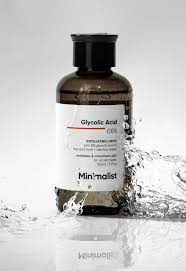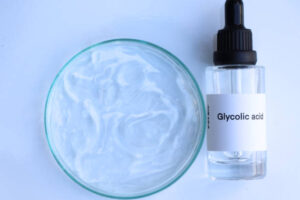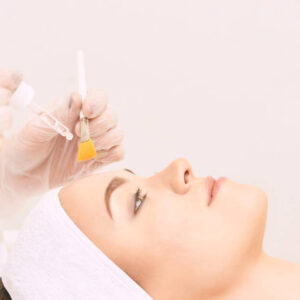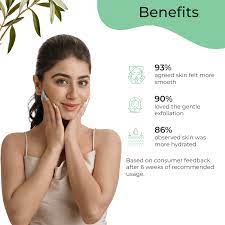Glycolic acid is a type of alpha hydroxy acid (AHA) that is commonly used in skincare products for its exfoliating and skin-renewing properties. It is derived from sugarcane and belongs to a family of acids known for their ability to improve skin texture, tone, and overall appearance.

Glycolic acid for the skin:
Glycolic acid is known for its ability to exfoliate the skin. It works by loosening and removing the top layer of dead skin cells, which can lead to smoother and brighter skin. Regular use of glycolic acid can help improve skin texture, making it appear smoother and more even. It can be beneficial for those with rough or uneven skin. Glycolic acid can help reduce the appearance of hyperpigmentation, dark spots, and sun damage. It promotes the turnover of skin cells, revealing newer, more evenly pigmented skin. Glycolic acid can stimulate collagen production, which is essential for maintaining skin elasticity and reducing the appearance of fine lines and wrinkles.

Glycolic acid can be effective in treating acne-prone skin. It can help unclog pores, reduce the formation of acne lesions, and fade post-inflammatory hyperpigmentation. While glycolic acid is an exfoliant, it can also help the skin retain moisture by improving the skin’s natural barrier function. Glycolic acid can be found in various skincare products, including cleansers, toners, serums, creams, and chemical peels. The concentration of glycolic acid in these products can vary.
Read Also: Revitalize Skin with Lactic Acid
BEST INGREDIENT FOR SKIN
EXFOLITATION with stronger formulations typically found in professional peels. Before using products containing glycolic acid, it’s a good idea to perform a patch test on a small area of your skin to check for any adverse reactions or allergies. Glycolic acid can make the skin more sensitive to the sun, so it’s crucial to wear sunscreen daily when using glycolic acid products to protect your skin from UV damage. If you’re new to glycolic acid, start with lower concentrations and gradually increase as your skin becomes accustomed to it.
Read Also: The Power of Mandelic Acid Revealed
Overuse or using high concentrations too quickly can lead to irritation. If you have specific skin concerns or if you’re considering stronger glycolic acid treatments, it’s advisable to consult with a dermatologist or skincare professional. They can recommend the most suitable products or in-office treatments for your skin type and concerns. Be cautious when using glycolic acid in combination with other active ingredients like retinoids or benzoyl peroxide, as it may increase the risk of irritation. Consult with a skincare professional for guidance on combining products safely. Various forms of Glycolic acid used for skin.

Cleansers containing glycolic acid offer a gentle way to incorporate this ingredient into your daily skincare routine. They help exfoliate the skin while cleansing, leaving it smoother and brighter. Glycolic acid toners are applied after cleansing to help further exfoliate and prepare the skin for the absorption of other products. They can be especially beneficial for those with oily or acne-prone skin. Glycolic acid serums typically have a higher concentration of glycolic acid and are designed for more targeted treatment. They can help improve skin texture, reduce the appearance of fine lines and wrinkles, and address hyperpigmentation.
Glycolic acid masks are formulated to provide a more intensive exfoliation. They are often used as weekly or bi-weekly treatments to promote skin renewal and radiance. Some moisturizers and night creams contain glycolic acid to provide both hydration and exfoliation. These products are suitable for daily use and can help.
BOONS OF GLYCOLIC ACID
Improve skin texture and tone over time. Glycolic acid peels are professional treatments typically performed in a dermatologist’s office or medical spa. They use higher concentrations of glycolic acid to provide a deeper exfoliation and are effective for addressing more severe skin concerns, such as acne scarring and deep wrinkles. Some spot treatments, such as acne spot treatments or targeted anti-aging products, contain glycolic acid to address specific areas of concern.
Glycolic acid can also be found in body lotions, creams, and treatments to address concerns like rough skin on elbows and knees, keratosis pilaris (commonly known as “chicken skin”), and body acne. These pre-soaked pads or wipes are convenient for on-the-go exfoliation and can be used to refresh and brighten the skin throughout the day. These are small adhesive patches infused with glycolic acid. They can be applied to specific blemishes or areas of concern to help exfoliate and promote healing.

Concentration of glycolic acid for the skin:
Glycolic acid is available in various skincare products with concentrations ranging from very mild to strong.
Low Concentrations (2% to 5%): Products with lower concentrations of glycolic acid are typically suitable for daily use and are well-tolerated by most skin types. They can provide gentle exfoliation and help improve skin texture, brightness, and overall appearance. These products are often found in cleansers, toners, and some moisturizers.

Moderate Concentrations (5% to 10%): Products with moderate concentrations of glycolic acid offer more significant exfoliation and can address a broader range of skin concerns, including mild to moderate acne, fine lines, and hyperpigmentation. They are often found in serums, creams, and masks. Beginners to glycolic acid may start with concentrations in this range and gradually increase use if their skin tolerates it well.
Read Also: The Power of Beta Hydroxy Acid
Higher Concentrations (10% to 30%): Products with higher concentrations of glycolic acid are usually intended for more targeted and intensive treatments. These may include chemical peels, in-office treatments, or stronger at-home treatments. These concentrations are typically recommended for individuals with specific skin concerns and should be used with caution. Consulting a dermatologist or skincare professional is advisable before using products with high concentrations of glycolic acid.
Professional Peels (30% and above): Glycolic acid peels with concentrations of 30% or higher are considered professional-grade treatments. They are typically administered by dermatologists, estheticians, or other trained skincare professionals. These peels provide a deep exfoliation and are effective for addressing more severe skin concerns such as deep wrinkles, acne scarring, and uneven skin tone.
When incorporating glycolic acid into your skincare routine, it’s essential to consider your skin type and concerns, as well as the concentration of glycolic acid in the product. Start with lower concentrations if you are new to glycolic acid and gradually increase as needed, while monitoring your skin for any signs of irritation. If you have sensitive or dry skin, it’s advisable to consult with a dermatologist or skincare professional to determine the best products and regimen for your specific needs.
